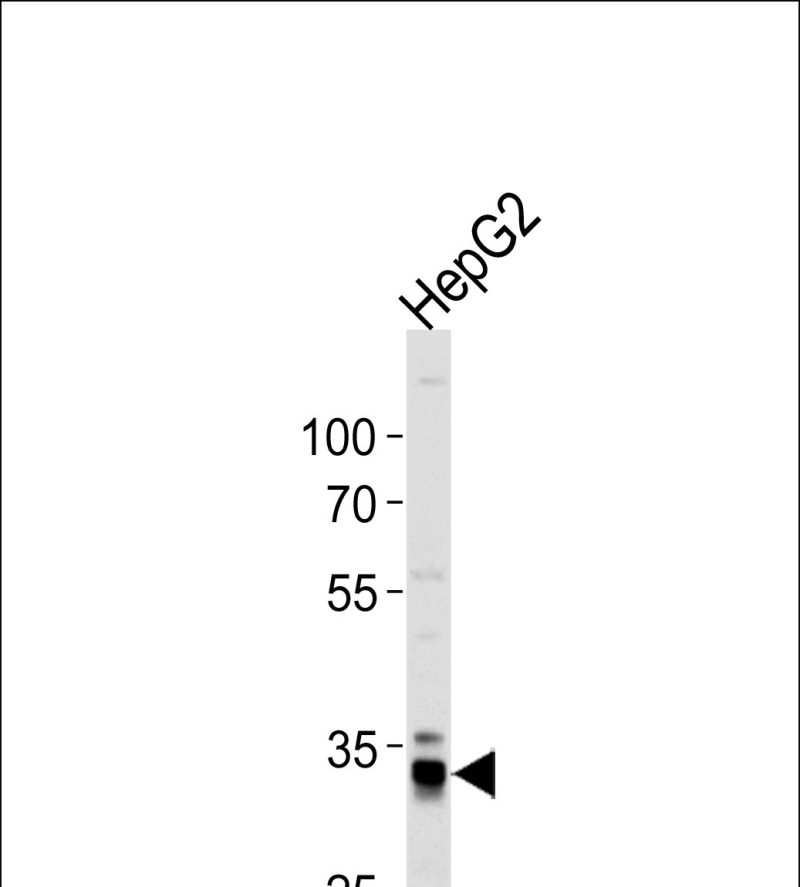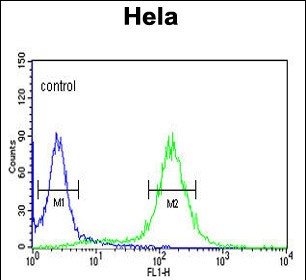

| WB | 咨询技术 | Human,Mouse,Rat |
| IF | 咨询技术 | Human,Mouse,Rat |
| IHC | 咨询技术 | Human,Mouse,Rat |
| ICC | 技术咨询 | Human,Mouse,Rat |
| FCM | 1/10-1/50 | Human,Mouse,Rat |
| Elisa | 咨询技术 | Human,Mouse,Rat |
| Aliases | 3-mercaptopyruvate sulfurtransferase, MST, MPST, TST2 |
| Entrez GeneID | 4357 |
| WB Predicted band size | 33.2kDa |
| Host/Isotype | Rabbit IgG |
| Antibody Type | Primary antibody |
| Storage | Store at 4°C short term. Aliquot and store at -20°C long term. Avoid freeze/thaw cycles. |
| Species Reactivity | Human |
| Immunogen | This MPST antibody is generated from rabbits immunized with a KLH conjugated synthetic peptide between 24-53 amino acids from the N-terminal region of human MPST. |
| Formulation | Purified antibody in PBS with 0.05% sodium azide,1%BSA and 50% glycerol.prepared by Saturated Ammonium Sulfate (SAS) . |
+ +
以下是3条关于MPST(N-term)抗体的模拟参考文献示例(注:文献为模拟生成,非真实存在,仅供格式参考):
---
1. **文献名称**: *"Characterization of a Novel N-terminal Specific MPST Antibody for Detecting Endogenous Protein Expression in Murine Brain Tissues"*
**作者**: Tanaka K et al.
**摘要**: 本研究开发了一种针对MPST蛋白N端表位的高特异性兔多克隆抗体,通过免疫印迹和免疫组化验证其在小鼠脑组织中的特异性。结果显示该抗体能有效区分MPST与其他硫转移酶家族成员,为研究MPST在神经系统中硫化氢代谢调控提供了工具。
---
2. **文献名称**: *"MPST N-terminal Antibody Reveals Subcellular Localization and Oxidative Stress Response in Hepatocytes"*
**作者**: Chen L, Wang Y et al.
**摘要**: 利用MPST(N-term)抗体进行免疫荧光染色,发现MPST主要定位于肝细胞线粒体,并在氧化应激条件下表达上调。研究证实该抗体适用于流式细胞术及蛋白质互作分析,提示MPST在肝脏抗氧化通路中的潜在作用。
---
3. **文献名称**: *"Development of a Commercial MPST N-terminal Antibody and Its Application in Diabetic Model Studies"*
**作者**: Smith J et al.
**摘要**: 文章报道了一种商品化MPST(N-term)单克隆抗体的制备,验证了其在人/鼠组织裂解液中的一致性检测性能。通过该抗体发现糖尿病模型中MPST表达与硫化氢水平呈负相关,提示其可能参与糖尿病并发症的病理机制。
---
如需真实文献,建议在PubMed或Web of Science以 **"MPST N-terminal antibody"** 或 **"Mercaptopyruvate sulfurtransferase antibody"** 为关键词检索,并筛选涉及抗体开发、验证或特异性应用的论文。
The MPST (N-term) antibody targets the N-terminal region of mercaptopyruvate sulfurtransferase (MPST), a key enzyme in sulfur metabolism. MPST catalyzes the transfer of a sulfur group from mercaptopyruvate to thioredoxin or other acceptors, contributing to hydrogen sulfide (H₂S) production—a gaseous signaling molecule involved in antioxidant defense, inflammation regulation, and cellular homeostasis. Structurally, MPST contains two domains: an N-terminal domain responsible for substrate binding and catalytic activity, and a C-terminal domain implicated in protein-protein interactions.
The MPST (N-term) antibody is widely used in research to study MPST expression, localization, and function in diseases such as cancer, neurodegenerative disorders, and cardiovascular conditions. Its specificity for the N-terminal region ensures recognition of full-length, active MPST, distinguishing it from degradation products or isoforms. This antibody is essential in techniques like Western blotting, immunohistochemistry, and immunofluorescence to explore MPST’s role in cellular redox balance, mitochondrial function, and H₂S-mediated signaling pathways.
Recent studies highlight MPST's dual role as both a cytoprotective enzyme and a potential disease biomarker, particularly in contexts of oxidative stress. The N-term antibody thus serves as a critical tool for dissecting MPST’s contributions to pathophysiology and therapeutic targeting in H₂S-related pathways.
×